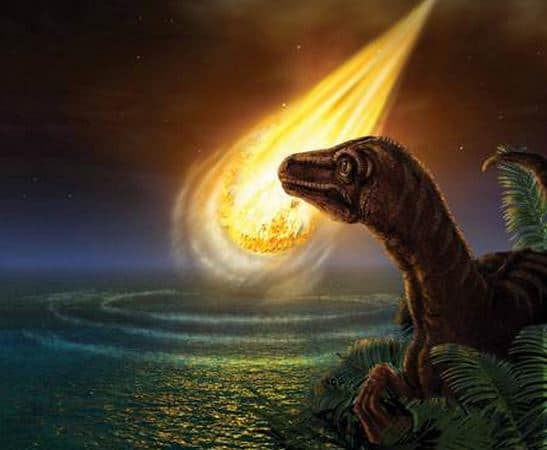Planet Earth occasionally passes around and through the Milky Way’s disc, which is full of dark matter and could influence the occurrence of geological and biological phenomena, including the extinction of species, such as the dinosaurs.
Professor Michael Rampino, a Biology Professor at New York University, wrote in a paper in the journal Monthly Notices of the Royal Astronomical Society (citation below), that Earth’s movement through dark matter may interfere with the orbits of comets and lead to extra heating in the Earth’s core, which could be associated with mass extinction events.
The Galactic disc is the plane in which bars, spirals and discs of disc galaxies exist. Galaxy discs typically have more dust and gas, as well as younger stars. Our solar system resides in the Galactic disc. It also has a concentration of dark matter – small subatomic particles which cannot be detected by their emitted radiation but whose presence can be inferred from gravitational effects on visible matter.

Michael Rampino concludes that Earth’s path around and through our Galaxy disc region of the Milky Way (above), where our solar system resides, may be directly linked to biological and geological phenomena occurring on Earth. (Image: nyu.edu)
According to previous studies, the Earth rotates around the disc-shaped Galaxy once every 250 million years.
Along its wavy path, our Solar System weaves through the crowded disc about once every 30 million years.
After analyzing the pattern of Earth’s route through the Galactic disc, Prof. Rampino noticed that these disc passages seem to coincide with periods in our history of mass extinctions of life and comet impacts.
When the famous comet hit Earth 66 million years ago and led to the extinction of dinosaurs, our Solar System was going through the crowded disc.
Why the link?
Why is there a correlation between Earth’s passing through the Glactic disc and the impacts and extinctions that follow?
Prof. Rampino observed that while traveling through the disc, the dark matter concentrated there disturbs the pathways of comets in the area that are typically orbiting far from Earth in the outer Solar System.
Rather than traveling far away from Earth, these comets take unusual paths, with more of them coming in our direction.
Prof. Rampino was surprised to find that with each dip through the disc, dark matter appears to accumulate within the Earth’s core.

Prof. Rampino believes there is probably a link between concentrations of dark matter and the extinction of the dinosaur.
The dark matter particles eventually annihilate each other, but produce considerable heat in the process. This additional heat in the Earth’s core might trigger volcanic eruptions, magnetic field reversals, changes in sea levels, and mountain building – events which show peaks every 30 million years.
Therefore, Prof. Rampino suggests that “astrophysical phenomena derived from the Earth’s winding path through the Galactic disc, and the consequent accumulation of dark matter in the planet’s interior, can result in dramatic changes in Earth’s geological and biological activity.”
His model, which points to dark matter interactions with Earth as it weaves through the Milky Way, could have a broad impact on how scientists understand the biological and geological development of Earth, as well as other planets in our Galaxy.
“We are fortunate enough to live on a planet that is ideal for the development of complex life. But the history of the Earth is punctuated by large scale extinction events, some of which we struggle to explain.”
“It may be that dark matter – the nature of which is still unclear but which makes up around a quarter of the universe – holds the answer. As well as being important on the largest scales, dark matter may have a direct influence on life on Earth.”
He suggests that in future geologists should consider incorporating his astrophysical findings in order to better understand events that are hitherto thought to result purely from causes inherent to the Earth.
Rampino adds that this model similarly provides deeper insight into the possible distribution and behavior of dark matter within the Milky Way.
Citation: “Disc dark matter in the Galaxy and potential cycles of extraterrestrial impacts, mass extinctions and geological events,” Michael R. Rampino. Monthly Notices of the Royal Astronomical Society. Published online Feb 18, 2015. DOI: 10.1093/mnras/stu2708.
